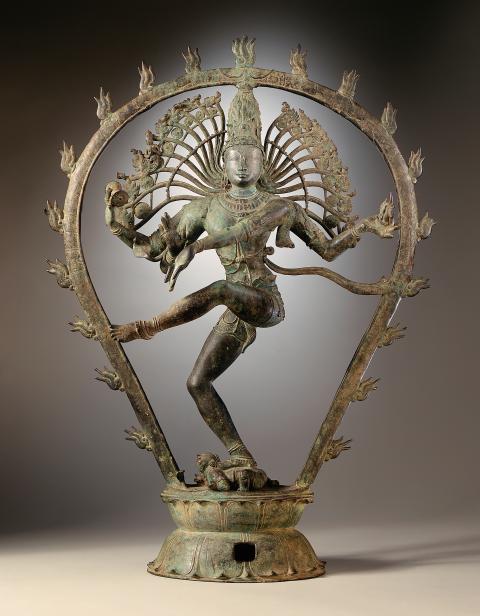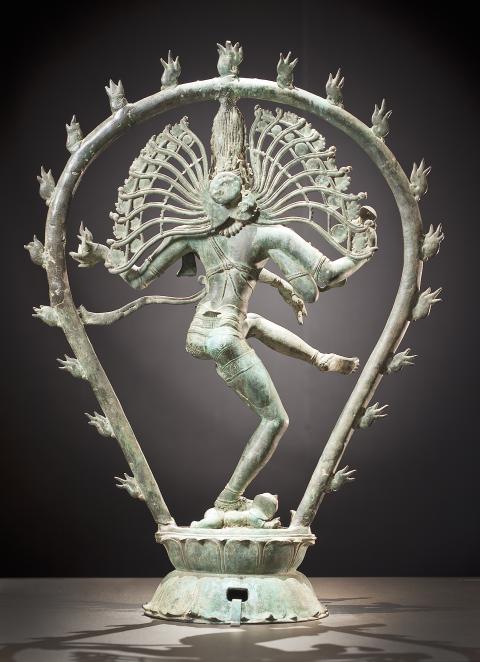The Hindu trinity of supreme divinity — the Trimurti — consists of Brahma the creator, Vishnu the preserver and Shiva the destroyer. Hindu cosmology includes the endless cycle of destruction and rebirth, in which destruction entails eradicating worldly delusion and imperfection, to facilitate transformation. Therefore, the deity of destruction represents not calamity, but instead a formidable regenerative force. It is for this reason that Shiva is worshipped.
Shiva has many guises, and this bronze sculpture is a classic work representing the deity as Nataraja, the Lord of Dance. Shiva’s dance is known as the cosmic dance, the energy that sets the universe in motion. Dancing between ecstasy and fury, the cosmos is destroyed only to emerge once again.
Details such as posture and gesture in religious sculpture generally have symbolic meaning in iconography, and this sculpture is no exception. The halo of flames surrounding the statue represents the universe. The drum Shiva is holding in his right hand on the rear pair of arms symbolizes the creation of the universe, while the flame held in his left hand on the rear pair of arms represents destruction. The right hand of his fore pair of arms is making the abhaya mudra gesture of fearlessness. The god’s right foot is standing on the dwarf Apasmara, who represents ignorance. This form of Shiva as Lord of Dance first appeared during the southern Indian Chola Dynasty (4th to 13th century BC), and was transmitted far and wide.

Photo courtesy of Los Angeles County Museum
照片:洛杉磯郡立美術館提供
Shiva was both the god of music and dance. Legend has it that he was the originator of dance, and could perform 108 types of dance, both feminine and masculine. Shiva’s Lord of Dance form is androgynous: Clean shaven, elegant and dignified.
(Translated by Paul Cooper)
印度神話中的三位主神是創造之神梵天、維護之神毗濕奴,以及毀滅之神濕婆。印度教的宇宙觀是不斷的毀滅與重生的循環──毀滅,是要破壞世上的虛幻與不完美,以促成轉變──因此毀滅之神不但不是災難性的,反而是代表強大無比的再生力量,濕婆因此極受崇拜。

Photo courtesy of Los Angeles County Museum
照片:洛杉磯郡立美術館提供
濕婆有許多種「相」,這件銅雕所呈現的是濕婆「舞蹈之王」相的典型作品。濕婆的舞蹈被稱為「宇宙之舞」,是運轉宇宙的動能──在跳舞的狂喜與狂怒中,宇宙灰飛煙滅、風雲再起。
宗教造像的舉手投足等細節,往往都有圖像學的象徵意義,這件雕塑也不例外:有火焰的外環代表宇宙,濕婆的後方右手拿著象徵宇宙創造的鼓,後方左手托著的火焰代表毀滅,前方右手呈「無畏印」的手勢;祂的右腳所踩的是象徵無知的小鬼。這樣的濕婆舞王像結構在南印度朱羅王朝(西元四世紀至十三世紀)時期出現,並廣為流傳。
濕婆也是音樂及舞蹈之神──傳說祂是印度舞蹈的始祖,會跳一百零八種舞,包括女性的柔軟舞,以及男性的剛健舞。濕婆舞王像無鬚、姿態優美、華麗莊嚴,有如雌雄同體。
(台北時報林俐凱)

When it comes to movies, some people delight in watching spine-chilling horror films. Surprisingly, apart from containing a few scares, horror movies may also offer an unexpected __1__. According to a study, watching 90 minutes of a scary movie can burn an average of 113 calories, which is roughly __2__ to taking a 30-minute walk. Researchers from the University of Westminster carried out an experiment in which they __3__ participants’ oxygen intake, carbon dioxide output, and heart rates while they were watching horror movies without any distractions. The results revealed that physiological responses to fear play a crucial role

Bilingual Story is a fictionalized account. 雙語故事部分內容純屬虛構。 Echo pulled out a worn and tattered shoe box under father’s large oak desk. “Mariko, what should we do with these family photos?” Mariko stared at the old box with a slightly hurt expression, and then blankly at the photos. “Throw them in the garbage pile. . . along with that old, ratty box,” she murmured. She resented that her father had not cared enough to find a nicer home for the family photos. “Father never really cared about me anyway.” Echo’s emotion sensor detected sorrow. ”Mariko, that is

In the vast landscapes of Australia, a unique and charming creature roams — the “wombat.” These round, adorable animals possess surprising abilities and fascinating traits that never fail to amaze. Let’s explore the world of this remarkable creature. Wombats are marsupials native to Australia, measuring around one meter in length and weighing between 20 and 35kg. Their fur varies in color, ranging from brown to gray to black. As herbivores, they primarily feed on grass, bark and roots. To adapt to Australia’s weather conditions, wombats have developed a slow metabolism and a leisurely pace. However, despite their bulky appearance,

Dos & Don’ts — 想想看,這句話英語該怎麼說? 1. 你覺得這部電影怎樣? ˇ What do you think of the movie? χ How do you like the movie? χ How do you think of the movie? 註︰What do you think of = What is your opinion of。 think 的受詞是 what,不能用 how。 2. 你認為哪一個歌星唱得最好? ˇ Which singer do you think is the best? χ Do you think which singer is the best? 註︰英語中 which singer 似乎是 do you think 的受詞,實則 do you think 是插入語,其他例子如下: 你以為他喜歡誰? Who do you think he likes? 你以為我住在哪裏? Where do you think I live? 你想我昨天在公園裏碰到了誰? Whom/Who do you think I met in the park yesterday? 3. 他不論到什麼地方,總是帶著一把雨傘。 ˇ No matter where he goes, he